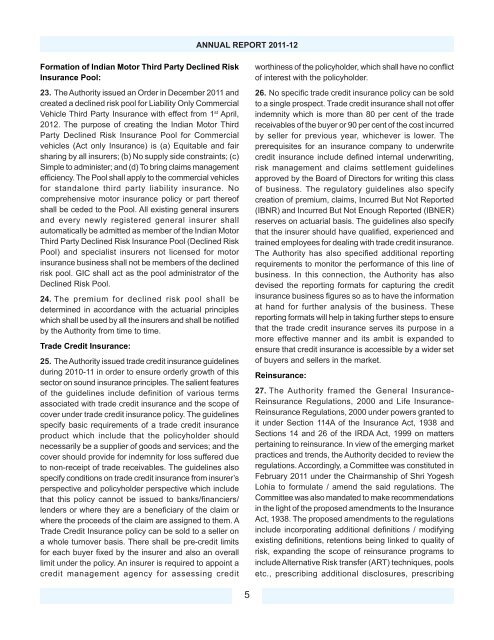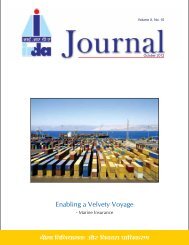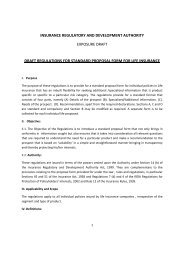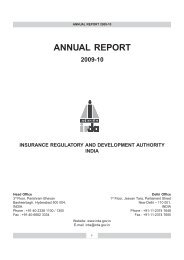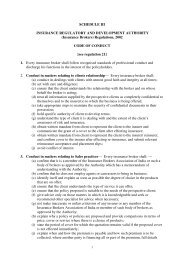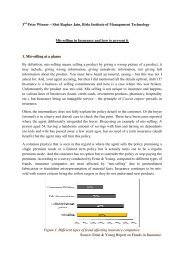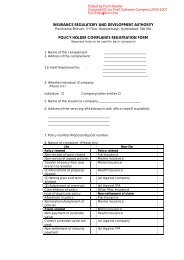Download PDF - IRDA
Download PDF - IRDA
Download PDF - IRDA
Create successful ePaper yourself
Turn your PDF publications into a flip-book with our unique Google optimized e-Paper software.
ANNUAL REPORT 2011-12<br />
Formation of Indian Motor Third Party Declined Risk<br />
Insurance Pool:<br />
23. The Authority issued an Order in December 2011 and<br />
created a declined risk pool for Liability Only Commercial<br />
Vehicle Third Party Insurance with effect from 1 st April,<br />
2012. The purpose of creating the Indian Motor Third<br />
Party Declined Risk Insurance Pool for Commercial<br />
vehicles (Act only Insurance) is (a) Equitable and fair<br />
sharing by all insurers; (b) No supply side constraints; (c)<br />
Simple to administer; and (d) To bring claims management<br />
efficiency. The Pool shall apply to the commercial vehicles<br />
for standalone third party liability insurance. No<br />
comprehensive motor insurance policy or part thereof<br />
shall be ceded to the Pool. All existing general insurers<br />
and every newly registered general insurer shall<br />
automatically be admitted as member of the Indian Motor<br />
Third Party Declined Risk Insurance Pool (Declined Risk<br />
Pool) and specialist insurers not licensed for motor<br />
insurance business shall not be members of the declined<br />
risk pool. GIC shall act as the pool administrator of the<br />
Declined Risk Pool.<br />
24. The premium for declined risk pool shall be<br />
determined in accordance with the actuarial principles<br />
which shall be used by all the insurers and shall be notified<br />
by the Authority from time to time.<br />
Trade Credit Insurance:<br />
25. The Authority issued trade credit insurance guidelines<br />
during 2010-11 in order to ensure orderly growth of this<br />
sector on sound insurance principles. The salient features<br />
of the guidelines include definition of various terms<br />
associated with trade credit insurance and the scope of<br />
cover under trade credit insurance policy. The guidelines<br />
specify basic requirements of a trade credit insurance<br />
product which include that the policyholder should<br />
necessarily be a supplier of goods and services; and the<br />
cover should provide for indemnity for loss suffered due<br />
to non-receipt of trade receivables. The guidelines also<br />
specify conditions on trade credit insurance from insurer’s<br />
perspective and policyholder perspective which include<br />
that this policy cannot be issued to banks/fi nanciers/<br />
lenders or where they are a benefi ciary of the claim or<br />
where the proceeds of the claim are assigned to them. A<br />
Trade Credit Insurance policy can be sold to a seller on<br />
a whole turnover basis. There shall be pre-credit limits<br />
for each buyer fi xed by the insurer and also an overall<br />
limit under the policy. An insurer is required to appoint a<br />
credit management agency for assessing credit<br />
worthiness of the policyholder, which shall have no conflict<br />
of interest with the policyholder.<br />
26. No specific trade credit insurance policy can be sold<br />
to a single prospect. Trade credit insurance shall not offer<br />
indemnity which is more than 80 per cent of the trade<br />
receivables of the buyer or 90 per cent of the cost incurred<br />
by seller for previous year, whichever is lower. The<br />
prerequisites for an insurance company to underwrite<br />
credit insurance include defi ned internal underwriting,<br />
risk management and claims settlement guidelines<br />
approved by the Board of Directors for writing this class<br />
of business. The regulatory guidelines also specify<br />
creation of premium, claims, Incurred But Not Reported<br />
(IBNR) and Incurred But Not Enough Reported (IBNER)<br />
reserves on actuarial basis. The guidelines also specify<br />
that the insurer should have qualifi ed, experienced and<br />
trained employees for dealing with trade credit insurance.<br />
The Authority has also specifi ed additional reporting<br />
requirements to monitor the performance of this line of<br />
business. In this connection, the Authority has also<br />
devised the reporting formats for capturing the credit<br />
insurance business fi gures so as to have the information<br />
at hand for further analysis of the business. These<br />
reporting formats will help in taking further steps to ensure<br />
that the trade credit insurance serves its purpose in a<br />
more effective manner and its ambit is expanded to<br />
ensure that credit insurance is accessible by a wider set<br />
of buyers and sellers in the market.<br />
Reinsurance:<br />
27. The Authority framed the General Insurance-<br />
Reinsurance Regulations, 2000 and Life Insurance-<br />
Reinsurance Regulations, 2000 under powers granted to<br />
it under Section 114A of the Insurance Act, 1938 and<br />
Sections 14 and 26 of the <strong>IRDA</strong> Act, 1999 on matters<br />
pertaining to reinsurance. In view of the emerging market<br />
practices and trends, the Authority decided to review the<br />
regulations. Accordingly, a Committee was constituted in<br />
February 2011 under the Chairmanship of Shri Yogesh<br />
Lohia to formulate / amend the said regulations. The<br />
Committee was also mandated to make recommendations<br />
in the light of the proposed amendments to the Insurance<br />
Act, 1938. The proposed amendments to the regulations<br />
include incorporating additional defi nitions / modifying<br />
existing defi nitions, retentions being linked to quality of<br />
risk, expanding the scope of reinsurance programs to<br />
include Alternative Risk transfer (ART) techniques, pools<br />
etc., prescribing additional disclosures, prescribing<br />
5


